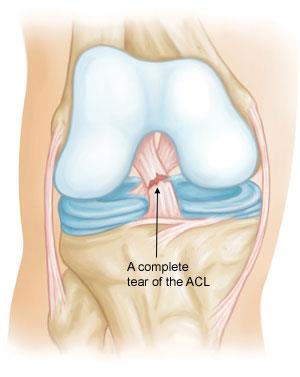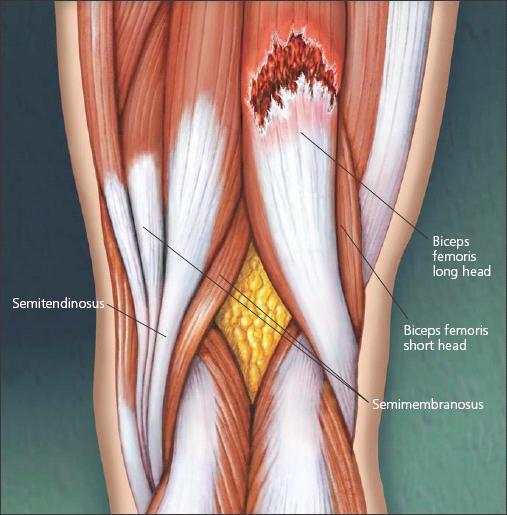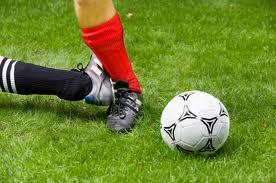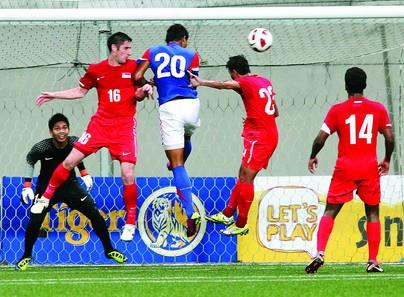Soccer continues to be one of the most popular team sports played all over the world with millions of fans admiring the sport. As it is the most common sports played by teenagers, the rate of soccer-related injury is increasing alarmingly.
 |
There are a lot of studies done by FIFA in determining the risk factors related to injuries. Researches have shown that there are 4 parts of the body that are at risk for injuries:
- Ankle
- Knee
- The most common injury in knee joint is ligament tear, the ACL (anterior cruciate ligament) being the most commonly affected. Players are usually tackled from the side and there is also twisting movement while the foot is on the ground.
- Players will often hear a ‘pop’ sound and develop immediate pain and swelling and ultimately unable to continue the game. After the pain and swelling subside, instability will be the main complaint.

ACL tear image from orthoinfo.aaos.org
- Hamstring
- Hamstring tear occurs quite often in a soccer player. It is often caused by sudden stretching of the muscle during sprinting or explosive movement. Pain, swelling and bruises are the symptoms.

Hamstring tear image from www.rehabandrevive.com - Incidence of recurrence for tear is high if the player does not complete the rehabilitation program properly.
- Hamstring tear occurs quite often in a soccer player. It is often caused by sudden stretching of the muscle during sprinting or explosive movement. Pain, swelling and bruises are the symptoms.
- Head
These risk factors can be categorized into two, which are Internal and External risk factor. Internal risk factors that are recognized are as follows:
- Age
- Studies have shown that younger age are related to higher risk of injury because of slower reaction times, lower skills and inadequate experience.
- Gender
- Studies have shown that female have higher risk of non-contact injuries especially over the anterior cruciate ligament (ACL) in the knee because of various reasons.
- Body Composition
- Multiple studies have proven that individual with higher body fat percentage have a higher risk of injuries.
- Previous history of injury
- Those who had previous injury in the same site or different body parts have higher tendency of getting injured at the same site.
- Cardiovascular fitness level
- Research has shown that individual with lower fitness level have higher risk of injury.
- Individual skill
- Players have different skills based on their training, coaching and also experience. Lower skills of playing predispose them to get injured easily.
- Body anatomy
While the external risk factors include:
- Human factors such as team mates, opponents and officials
- Coordination between teammates is crucial. Knowing your opponents capability is also important. Stick to rules of the games and always respect the referee’s decision.
- Protective equipment such as shin pad
As old man says, “Prevention is better than cure”. There are a few safety steps that need to be practiced:
- Warm up session before starting game
- FIFA have introduced sets of exercise which is called “The 11+” which is proven to reduce the rate of injuries.
- Stretching of the muscle and joints
- Researches have shown that cold muscles are more prone to injury. Always take your time to stretch properly especially your lower limbs.
- Ensuring your fitness level at satisfactory level
- Be sure that you are in a good physical condition before starting your game whether it’s a recreational or competitive one. A good program includes aerobic, strength training and flexibility.
- Cool down and stretch
- What happens after a game is usually players will forget to cool down. Be sure to stretch down your muscle in order to make your muscle flexible and reduce injury rate.
- Hydrate well
- Even mild dehydration can impair your performance. Playing full time soccer can cause considerable amount of sweat loss. Be sure to replace it with water or sport drinks.
- Sports equipment that are being used
- Use synthetic, non-absorbent balls on wet playing fields. Wet balls can become very heavy causing injuries to players especially while heading.
- Wear shoes with molded cleats or ribbed soles. Shoes with screw-in cleats often are associated with higher risk of injuries.
- Soccer goal posts should be well padded and properly secured. This will decrease the incidence of goalie or other players from getting head injury.
- Playing surfaces
- The playing surfaces must be well taken care. Holes on the field should be filled up, bare spots reseeded and debris removed.
- Weather condition
- During thunderstorms, leave the field and get inside immediately. In hot and humid condition, be sure to take plenty of fluids during breaks.
- Complete your rehabilitation program
- If you have previous injury, make sure you have completed your rehabilitation program. This is to ensure that the healing of injured part takes place completely and is ready to be maximally utilized again for the next game.
- An injured player must have his symptoms healed completely before entering the field again. For example, if you have knee joint injury, no pain or swelling, full range of motion and adequate muscle strength must be achieved.
- Prepare for injuries
- Coaches should be taught on knowledge of common soccer injuries and also about first aid, and how to administer it especially for minor injuries such as abrasions, cuts, minor strains and sprains.
- A medical doctor or physiotherapist should be available for any teams that are travelling for a game. For bigger tournaments, usually the organizing team will prepare their medical teams on the field.
- You should also know some basic knowledge on common injuries and first aid. Preparedness is often the best thing and seeking medical attention on injuries should follow.
- Prevent overuse injuries
- There’s an increasing trend that overuse injuries predominates in any sports which involve all year round training.
- Taking regular rest in between season of play can prevent this. Training intensity have to be lowered so that the body is able to cope with the demand from training.
References
- http://www.fifa.com/aboutfifa/footballdevelopment/medical/index.html
- www.sma.org.au
- Clinical Sports Medicine, Peter Brukner and Karim Khan
| Last Reviewed | : | 24 January 2014 |
| Writer | : | Lt. Kol. Dr. Ridzuan b. Azmi |
| Accreditor | : | Prof. Madya Dr. Ahmad Tajuddin b. Othman |











